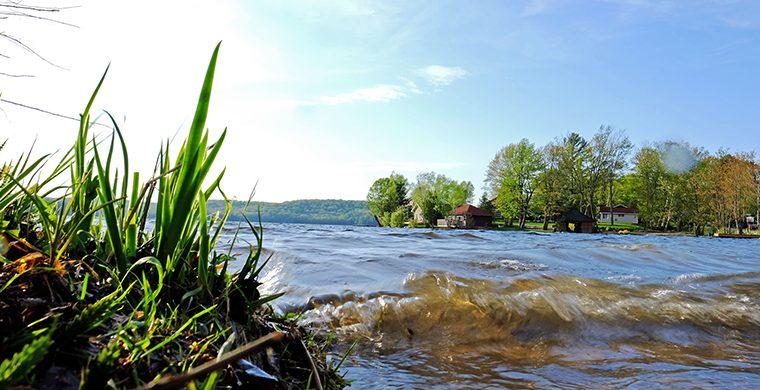By Mike Baker
There were many opposing opinions and viewpoints presented by members of the public during a virtual shoreline preservation bylaw open house, hosted by the County of Haliburton on Thursday evening [July 29].In what is arguably the most significant hot-button issue in the Highlands right now, members of council joined representatives from Hutchinson Environmental Sciences and JL Richards Associates – the firms tasked with providing an independent review of an all-encompassing shoreline bylaw document – in listening to 21 different delegates offer their thoughts and opinions on a piece of legislation that has been in the works at the county level for several years.Thursday’s meeting was borne out of a desire by county officials to open discussion on the issue and allow members of the community to provide feedback, months after attempts to push a bylaw through were met by vitriol by those who would be most impacted.So, what’s the story behind the bylaw? Haliburton County council has long held concerns over the health and water quality of lakes in the Highlands. Members have spent much of the past 18 months debating the merits of a bylaw, and what should be included.Back in January, a draft bylaw was tabled outlining several key items designed to protect water quality, while also acknowledging private land owners’ property rights. Perhaps the most controversial point was the inclusion of a 30-metre setback, essentially outlawing any and all development within 30-metres of any water body. The reason outlined for including the setback, county officials say, is to protect wildlife habitats and establish a natural, vegetative buffer that can help prevent potentially harmful substances from running into the water.Concerns have also been raised over the county’s plans to require any significant developments on lands affronting lakes to be put through a rigorous permit process.On Thursday, Jason Ferrigan, a senior planner with JL Richards, said this was the first of two open houses planned as part of this independent review of a potential shoreline preservation bylaw.He explained the role he and his team will play throughout this process, which he expects will conclude in October.“In terms of our assignment, county council has tasked us with providing an independent and objective review of the tremendous amount of work that went into creating the draft shoreline preservation bylaw... That consists of three distinct, yet interrelated streams of work,” Ferrigan said. “First is a scientific literature review, second is then to go and look at successful practices elsewhere... Then talking to members of the public and stakeholders to understand their perspectives and views on the bylaw.”He estimates his team is around 40 per cent through the second portion of the work, and expects to be in a position to provide a report on preliminary findings to council in August.To date, as part of their work, Hutchinson Environmental Sciences has consulted with six scientific experts in the realm of shoreline preservation, and reviewed 54 papers related to shorelines, according to Brent Parsons, a senior aquatic scientist with the firm.“As part of our next step, [we] will review existing mechanisms in effect in the county... [and we are] currently researching approaches in other comparable municipalities. Through that research, we are going to summarize the legislative and planning mechanisms that are used, prohibitions, exemptions and effectiveness of policies, as well as document details such as specific setback distances, buffer sizes, minimum frontages and minimum lot sizes,” Parsons said.Ferrigan noted that, in his research thus far, he has identified that Haliburton County has 951 different bodies of water – including lakes, rivers, streams and ponds. Of those, 64 per cent are considered cold bodies of water, 4 per cent are cool bodies of water and 32 per cent are warm bodies of water.He pointed out too that there was a pretty even split in ownership of land that immediately fronts onto those bodies of water, with 51 per cent owned privately, and 49 per cent considered crown land.As a part of their review, Ferrigan and his team discussed the draft shoreline preservation bylaw with more than 20 stakeholders prior to Thursday’s meeting, with most of those discussions being quite fruitful.“It’s very clear to us that all stakeholders, regardless of perspectives, value the lakes in Haliburton. It’s also safe to say from the conversations we’ve had that stakeholders also support the idea of healthy lakes,” Ferrigan said. “I don’t think anyone wants to see water quality deteriorate on the lakes. People understand the lakes are important and want to see them be successful and sustainable in the future.”Bill Missen, a director with the Maple, Beech and Cameron Lakes’ Area Property Owners’ Association, said he sees the need for a document to properly protect natural shorelines in the Highlands, but finds the proposal brought forth by the county earlier this year “very prescriptive.”“I have three main issues – [first], the 30-metre rule. We were one of the lakes involved with the ‘Love Your Lake’ program, and we have to question how things have gone from a three-metre ribbon of life [for shoreline] to now, 30 metres. I find it overly excessive – looking at the science that supports 30-metres, that’s good, but we’re not sure what’s wrong with the science that also supports a shorter ribbon of life,” Missen said. “My second point is enforcement – it’s a large county, with 951 bodies of water... What’s the cost going to be [to police this] properly?”In his third point, Missen said that he takes exception to this bylaw infringing upon ownership rights.“Some lakefront property owners feel threatened by this bylaw. They shouldn’t feel threatened by anything, but least of all from our government,” Missen said. “Owners are feeling they’re totally losing control of their property, particularly if the 30-metre setback is introduced.”Dave Love, a lifelong cottager on Haliburton Lake, said he didn’t understand the need for any additional protection or legislation, bringing forward data that, he suggests, shows Haliburton’s lakes are doing just fine.“From what I have learned, the main objective here is to achieve shorelines classified as 75 per cent naturalized or regenerated, and by doing so that will help maintain high water quality, prevent algae blooms and prevent the risk of eroding shorelines and flooding,” Love said. “Proposing this bylaw... suggests to me that Haliburton’s lakes and shorelines are in such a state of deterioration as to require urgent government attention to save them from serious harm. I have searched for evidence of [this], but have been unable to find any.”Love pointed to a 2019 lake health report published by the Haliburton Property Owners Association, which states the shorelines of the community’s 60 largest lakes was already trending towards 75 per cent naturalized condition.He also pointed to the fact that three lakes in Algonquin Park, which are 100 per cent natural with no disturbed shoreline, were closed back in 2015, 2016 and 2017 due to algae blooms being found in the water.“Water quality is measured by several parametres, and according to that lake health report, 60 of Haliburton’s largest lakes met or exceeded those parametres in five of the six categories,” Love concluded.Susan Hay, herself a lakefront property owner, says she fully endorses the development of a shoreline preservation bylaw. A member of Environment Haliburton, Hay pointed to her own personal experiences over the past 18 months when discussing why a bylaw is necessary.“In November 2020, ten lakes in Haliburton had confirmed blue-green algae blooms, and one of them was on a lake where I reside... We had a lake-based water system. We were advised not to use our water for any reasons – we had to buy water for cooking, washing dishes and even bathing,” Hay said. “I share this story because I fear people don’t understand how awful it is to have this happen. The lake I live on is small, but busy. Annual phosphorous samples were always below the allowable level. We thought we were safe from the threat of blue-green algae, but we weren’t.”She believes climate change is having an impact on the quality of area lakes, and that preserving natural shorelines is the number one way to help offset those effects.Mike Thorne, lake steward for Gull Lake, said he had communicated with 218 members of his association prior to Thursday’s meeting, which accounts for around 50 per cent of property owners on the lake. When he asked his members to place a level of importance for maintaining natural shorelines, he said 94 per cent said it was of paramount importance.Deb Wratschko, president of the Kennisis Lake Cottage Owners’ Association, said she wasn’t in attendance on Thursday to support or debunk the bylaw, but simply to convey the opinions of the over 600 members of her association.“Maintaining healthy lakes and good water quality is a priority – there are only a few things we as individuals and a community can do to substantively protect water quality. One, to maintain and regularly inspect our septic systems to ensure they’re functioning properly. Two, protect existing shoreline vegetation to act as a buffer for nutrients and siltation entering our lakes. And third, eliminate the use of fertilizers on shoreline properties,” Wratschko said.Russ Wunker has lived on Miner’s Bay for 75 years, and formerly owned Miner’s Bay Lodge. He said that, if county council were truly serious about maintaining water quality, they would target a specific group of the population that are quite prevalent for several months of the year.“Why not proper monitoring of ice fishing? Most ice fishermen are not local, and sometimes there can be up to 100 huts on a single lake, with no [portable toilets] in view,” Wunker said. “There’s certainly lots of filth, garbage and debris left on the ice that drifts ashore in the spring. Where is the concern and regulation about this pollution to our lakes?”In total, there were 21 speakers to address council and the host firms on Thursday. Ferrigan said he was “very impressed” by the level of knowledge people brought to the table.He said that, for next steps, his team will be taking the feedback shared, reflect on it and, together with the environmental research carried out by Hutchinson Environmental Sciences, use it to compile a report it plans to present to county council in August.Following that meeting, a second open house will be organized, likely for September, to gather additional thoughts, before a final report is presented to council in October.










